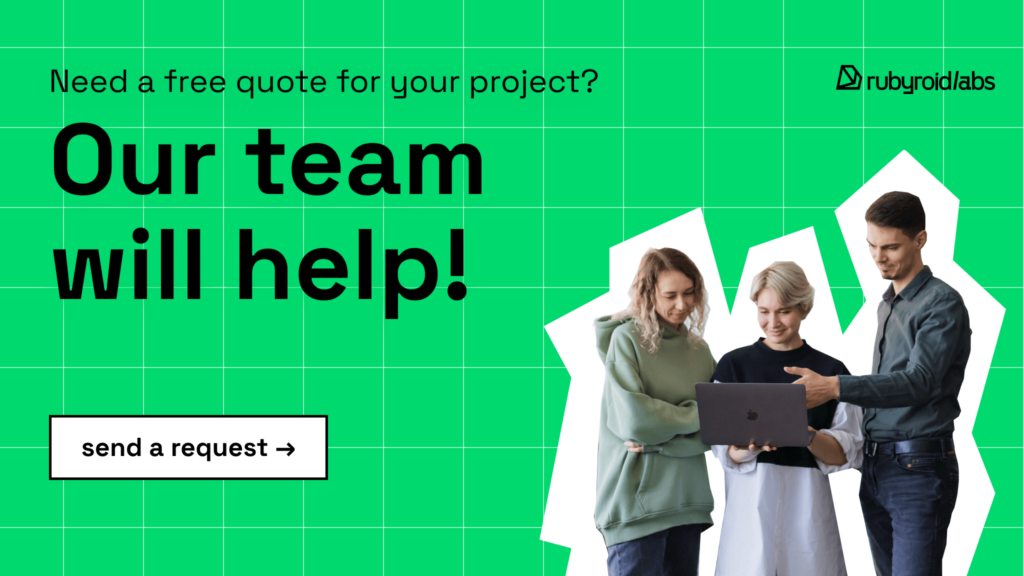Building a great product depends on two key factors: getting the right people on board and picking a tech stack that actually works for you.
The dev team side is usually pretty clear-cut. You evaluate skills, look at experience, and check if people have worked with the tools you need. Picking a framework, though, can be much trickier.
In this post, we’ll explore some popular frameworks, compare what they offer, and answer an important question: why choose Ruby on Rails, even if it’s not the trendiest option?
Contents
- Ruby on Rails: A Quick Overview
- Best Web Development Frameworks 2025: A Comparison Table
- Django vs Ruby on Rails: Performance and Ecosystem
- Node.js vs Ruby on Rails: Performance and Flexibility
- Laravel vs Ruby on Rails: Developer Experience and Hosting
- When to Choose Ruby on Rails
- Conclusion
Ruby on Rails: A Quick Overview
When you want to turn ideas into live web applications without unnecessary obstacles, Ruby on Rails (RoR) stands out as a trusted partner. And the reason why we’ve been choosing it again and again for over 12 years goes far beyond just convenience.
It’s not simply about saving time or following trends. RoR offers a thoughtful approach that supports both developers and businesses. By relying on proven patterns and sensible defaults, RoR clears away much of the clutter that can slow projects down. This allows teams to put their energy into building features that truly matter, rather than getting bogged down in repetitive tasks. Over the years, Rails has consistently helped us move from concept to launch faster and with more confidence, making the whole process smoother and more rewarding.
Back to History
Two decades ago, developers repeatedly built the same functionality from scratch: database handling, basic operations, and URL routing. Different skill levels across teams resulted in inconsistent quality and prolonged project timelines.
While creating Basecamp, David Heinemeier Hansson grew tired of this inefficient process. He identified the best practices from his development work and transformed them into Rails. The framework that standardized and accelerated web application building.
Rails Today
Today, Ruby on Rails centers around three fundamental commitments that set it apart from other frameworks.
- First, development flows smoothly because Rails automatically takes care of all the mundane configuration tasks behind the scenes.
- Second, you’re not starting from zero since Rails provides ready-made tools for the typical problems every web developer faces.
- Third, you can deploy with confidence because Rails uses proven patterns that naturally steer you toward solid development practices.
This freedom from technical busywork is what enables teams to move fast, adapt based on user input, and create products that truly connect with their audience.
At Rubyroid Labs, we’ve been providing Rails services and our expertise, helping clients around the world build high-performing and scalable projects.
Let’s take a deeper dive into its comparison with other frameworks.
Best Web Development Frameworks 2025: A Comparison Table
Before diving into discussions with developers, it helps to see web frameworks as the foundation beneath any digital project.
Much like architects choose specific materials for different buildings, selecting the right framework shapes how your application will be built, maintained, and scaled. In this overview, we’ll look at three major frameworks: Ruby on Rails, Django, Node.js/Express, and Laravel, highlighting what sets each apart and where they fit best, so you can make more informed choices.
| Framework | Strengths | Drawbacks | Ideal For | Less Suitable For | Accessibility Beginners, New Teams |
| Ruby on Rails | Convention over configuration, secure by default, rapid development, robust gem ecosystem | Strict structure, less optimal for building microservices | Web applications, startups, MVPs, CRUD-heavy apps, APIs, admin panels, ERP, CRM systems | Highly customized architectures | Easy but requires learning basic Ruby first. The concepts easier to grasp |
| Django (Python) | Complete toolkit with admin panel, scalability, and detailed documentation | May feel too rigid for small projects and lacks efficiency for real-time features | Data-heavy applications, content management systems | Real-time apps, chat systems | Moderate. Strong structure, but many default tools to learn. |
| Node.js / Express | Speedy, lightweight, flexible, great for real-time | Requires more setup, fragmented ecosystem | Enterprise apps, APIs, real-time apps | Complex admin systems, monolithic apps | Steep learning curve, no structural guidance, prone to architectural mistakes. |
| Laravel (PHP) | Clear syntax, built-in tools, good for teams | Performance overhead, PHP limitations | Web portals, dashboards, small-to-mid apps | High-load systems, real-time interactions | Easy to grasp due to clear structure and familiar patterns. |
Obviously, none of these toolsets excel at absolutely everything. What matters most is matching your selection to what your team can actually do, what your application demands, and what users and stakeholders expect, especially around launch timelines and when people can actually start using your product.
We’ll highlight the differences between the frameworks more thoroughly in the upcoming sections.
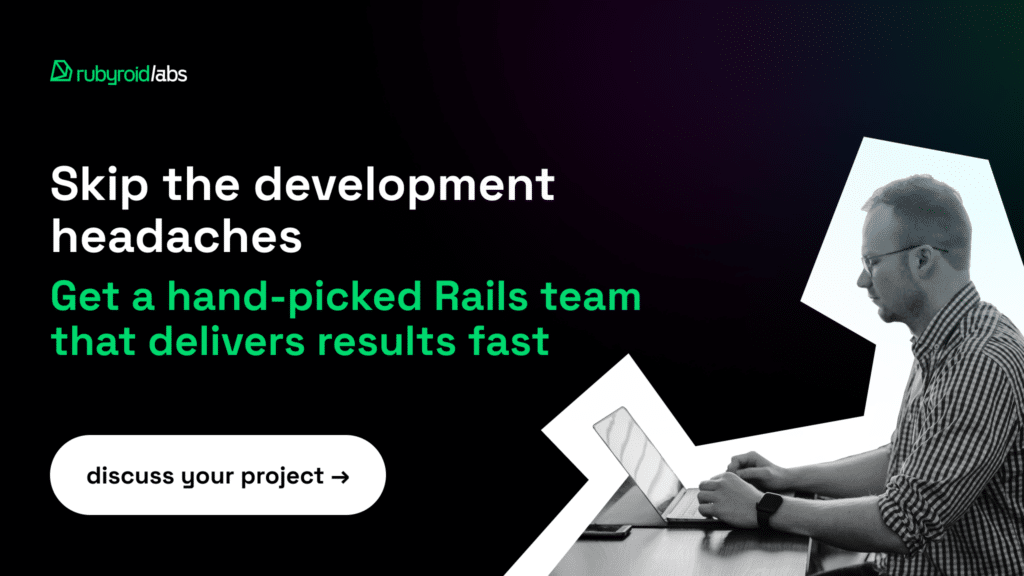
Django vs Ruby on Rails: Performance and Ecosystem
Django and Rails have many similarities in their fundamental capabilities, though each targets a bit different use cases.
- Each provides complete full-stack, server-side MVC architecture using powerful programming languages such as Python for Django and Ruby for Rails.
- Each framework offers extensive toolsets, including database management, administrative interfaces, and extension libraries. Although having robust toolsets is important, developers typically base their decision on which programming language they prefer.
We’ll examine their specific capabilities more closely.
Architecture
- Django:
Uses Model-View-Template (MVT) structure with clear separation of concerns. Following “explicit is better than implicit,” developers handle setup manually for greater control. Offers extensive database customization options. - RoR:
Automates decisions through built-in conventions, letting developers focus on features over configuration. Seamlessly maps data structures to database schemas for rapid development without complex queries.
Ecosystem Comparison
- Django
Comes with everything you need built-in like URL handling, authentication, and admin interfaces. Benefits from Python’s huge collection of tools, including data science libraries like pandas and NumPy, plus machine learning frameworks like TensorFlow and PyTorch. - RoR
Offers a curated selection of gems that solve common web problems. The framework makes tool choices for you, using trusted solutions like Devise for authentication, Sidekiq for background jobs, and RSpec for testing. Though the community is smaller, it’s laser-focused on web development with proven, reliable plugins.
Both frameworks provide strong ecosystems, yet Rails excels when rapid development is essential. With its comprehensive pre-built components and solid reputation among agile startups, Rails frequently becomes the catalyst that transforms concepts into live products. When prioritizing fast delivery and preparing for expansion, Rails proves exceptionally effective.
Developer Experience and Learning Curve
- Django
Offers transparent design where developers can see and control underlying processes. Requires more initial setup but provides greater project control. Features comprehensive documentation and logical structure. Easy to learn for Python developers. - RoR
Simplifies development by handling routine decisions automatically. Includes generators and scaffolding for faster app building. Ruby syntax has a learning curve initially, but developers become highly efficient once familiar with it.
Hosting and Deployment
- Django
Works with various web servers like Gunicorn and uWSGI, and packages well with Docker for consistent environments. Scales effectively on major cloud platforms like AWS, Google Cloud, and Azure with multiple deployment options. - RoR
Offers multiple deployment methods, from established tools like Capistrano to newer solutions like Kamal for container deployments. Works well with containerization and runs smoothly on major cloud platforms, including AWS Elastic Beanstalk, matching other leading frameworks.
Performance
- Django
Generally runs faster due to Python’s performance advantages. Excels at computational tasks and scientific operations. Includes built-in memory management and effective caching features. - RoR
Previously slower but recent Ruby improvements like just-in-time compilation have closed the gap. Now it performs similarly to Django for typical web tasks, with speed differences mainly coming from the languages rather than the frameworks. Performance improves with smart caching and optimized databases.
Both frameworks handle large numbers of users effectively.
When to Use and When To Avoid
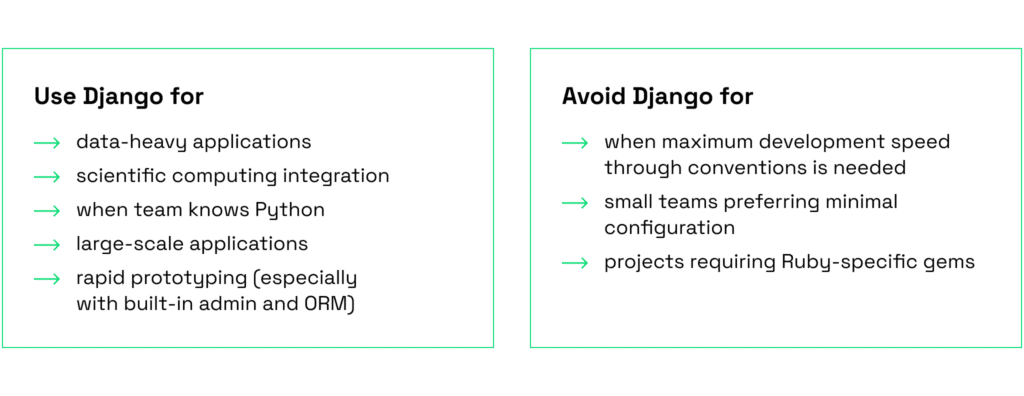
Both frameworks are strong contenders, but Ruby on Rails often gives teams the extra spring in their step needed for fast-paced, real-world projects, especially when deadlines are tight.
Django stands out in building well-organized, content-heavy sites, but Rails tends to hand teams the keys to a nimble vehicle, letting them steer their products in new directions as user needs evolve.
Node.js vs Ruby on Rails: Performance and Flexibility
In this comparison, Node.js refers to the JavaScript runtime paired with Express.js, the dominant web framework in its ecosystem. Rails delivers a complete full-stack experience with everything included, while Express stays minimal and allows developers greater choice in their tooling.
Here’s how they stack up across various aspects.
Architecture
- Node.js
Uses Google Chrome’s V8 engine and usually pairs with Express.js for website creation. Express gives you basic tools for routing and lets you build everything else your own way. Node.js is great at handling concurrent processes without slowing down, perfect for APIs and live features like chat or instant updates. - RoR
Follows the MVC (Model-View-Controller) pattern where Models store data, Views show pages, and Controllers handle requests. It follows “convention over configuration”, meaning it makes sensible choices for you. Handles multiple users at once through threading, making it great for organized, easy-to-maintain websites.
Developer Experience and Learning Curve
- Node.js
Uses JavaScript for both website frontend and backend, so no need to learn different languages. But developers spend time picking the right tools and deciding how to organize projects from many options. How hard it is to learn depends on which tools are chosen. - RoR
Makes developers happy by handling tedious decisions automatically. Comes with sensible defaults and clear guidelines, letting developers jump straight into building features. Particularly welcoming for newcomers wanting quick results, providing a well-marked path with less wandering and more building.
Ecosystems and Libraries
- Node.js
Has access to npm, the world’s largest package marketplace, giving developers freedom to pick exactly what they need. Popular tools include Express for web requests, Mongoose for databases, Socket.io for real-time features, and Jest for testing. - RoR
Includes most necessities out-of-the-box like web handling, database management (ActiveRecord), file management, and testing tools. While RubyGems is smaller than npm, it’s reliable and well-maintained. Popular additions include Devise for authentication, Pundit for authorization, and RSpec for testing.
Performance
- Node.js
Excels at handling lots of simultaneous users and quick input/output tasks, making it perfect for real-time apps, APIs, and chat systems. However, it struggles with heavy computational work because it essentially uses just one processing thread. - RoR
Slower with high-concurrency situations but works well for typical web applications. While not the fastest out of the box, its performance can be significantly improved with good caching and database optimization.
Hosting and Deployment
- Node.js
Runs on virtually any hosting platform like Vercel, Heroku, or AWS. The challenge is that different project structures and tool combinations often require customized deployment setups for each application. - RoR
Works well on most hosting platforms and with modern container deployments. RoR’s consistent structure means deployment setups can be reused across projects with minimal changes. Includes helpful tools like Kamal for containerized deployments and well-established deployment patterns.
Flexibility
- Node.js
Like having a blank canvas. Developers choose everything from databases to frameworks. This freedom enables custom solutions but requires more time making structural decisions. - RoR
Like getting a well-designed template with built-in best practices. Less flexible but provides proven solutions for common problems, enabling faster feature development through pre-made decisions.
Node.js gives you complete control but requires more upfront work, while Rails gets you building faster by handling the foundational decisions for you.
When To Use and When To Avoid
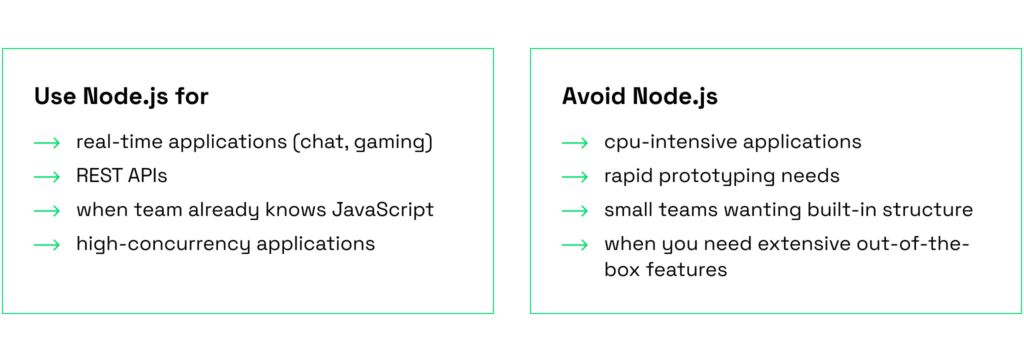
If you need to launch quickly with a competitive, scalable product, Rails is often the smarter choice, especially when you have an experienced team that knows how to leverage Rails’ ecosystem effectively.

Laravel vs Ruby on Rails: Developer Experience and Hosting
Laravel has established itself as the go-to framework for modern PHP projects, while Rails remains a top pick among startups and teams focused on fast product development, largely due to its opinionated design and ability to support rapid, iterative releases.
Let’s find the differences between these two.
Architecture
- Laravel
Uses MVC with more organizational flexibility. Service containers and dependency injection keep code organized. Artisan CLI handles repetitive tasks with configurable freedom - RoR
Follows strict MVC with Active Record pattern. Strong opinions on folder organization and naming conventions. The “convention over configuration” philosophy means Rails makes the decisions for you.
Developer Experience
- Laravel
Easy to learn with great documentation and tutorials. Clear code structure makes debugging simpler, and the Artisan tool automates repetitive tasks. - RoR
Harder to learn initially because it relies on conventions and hidden behaviors. Once you understand the patterns, development becomes very fast with little setup needed.
Laravel suits PHP developers seeking adaptability and control.
Rails delivers a streamlined, highly efficient workflow, making it an excellent choice for startups and product-focused teams aiming for rapid progress.
Hosting and Deployment
- Laravel
Works on most hosting platforms from shared servers to cloud providers. Easy deployment with tools like Laravel Forge. PHP’s popularity means cheap, plentiful hosting options. - RoR
Needs specialized hosting with fewer budget options. Works well on Heroku, DigitalOcean, and AWS. Tools like Capistrano offer advanced deployment but require more complex setup.
Laravel is perfect for developers wanting easy, cost-effective hosting solutions.
Rails is best suited for modern cloud environments focused on scaling and advanced deployment workflows.
Ecosystems and Libraries
- Laravel
Composer offers thousands of PHP packages, including Symfony components, Stripe SDK, and business tools. Strong e-commerce ecosystem with packages like Laravel Cashier for subscriptions and Spatie libraries for common features. - RoR
RubyGems provides quality libraries like CanCanCan for authorization, Kaminari for pagination, and CarrierWave for file uploads. These gems are optimized for Rails and work seamlessly with minimal configuration.
Performance Comparison
- Laravel
Tends to deliver quicker execution times, thanks to PHP’s efficient engines like PHP-FPM. It also supports robust caching solutions such as Redis and Memcached and usually consumes less memory for typical apps. - RoR
Execution can be slower, mainly due to Ruby’s interpreter, not the Rails framework itself. However, Rails offsets this with rapid development speed. High-traffic projects may require extra performance tuning and optimization.
When To Use and When To Avoid
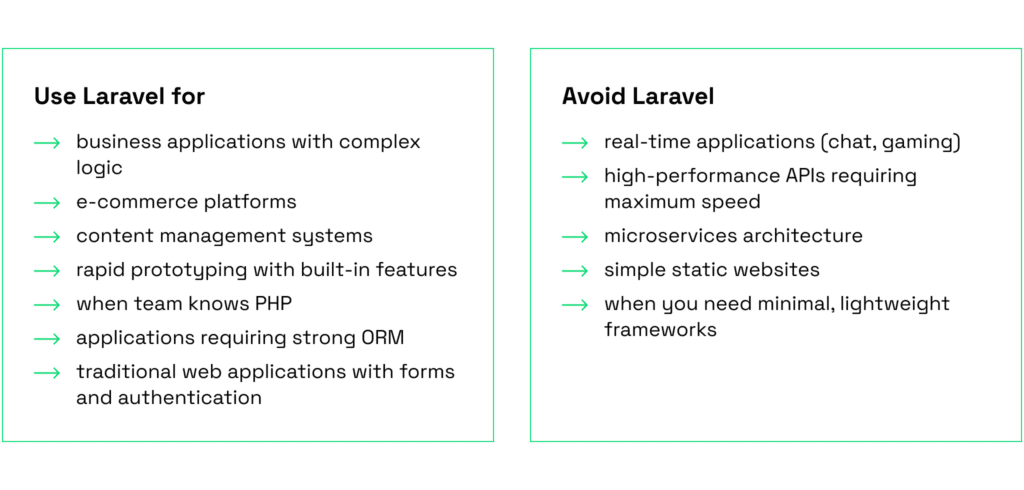
Laravel and Ruby on Rails have both proven themselves as reliable, feature-rich options with strong communities behind them. Deciding between the two really hinges on your team’s skill set, the specific needs of your project, and your approach to deployment and ongoing maintenance.
When to Choose Ruby on Rails
When you put Ruby on Rails up against other frameworks, each technology shows its unique strengths. Node.js leads in real-time features, while Django excels at handling complex data workflows.
RoR has carved out its own sweet spot in the development landscape.
With its proven conventions, accelerated build times, and rich ecosystem, Rails delivers exceptional performance in particular use cases where it truly becomes the standout choice.
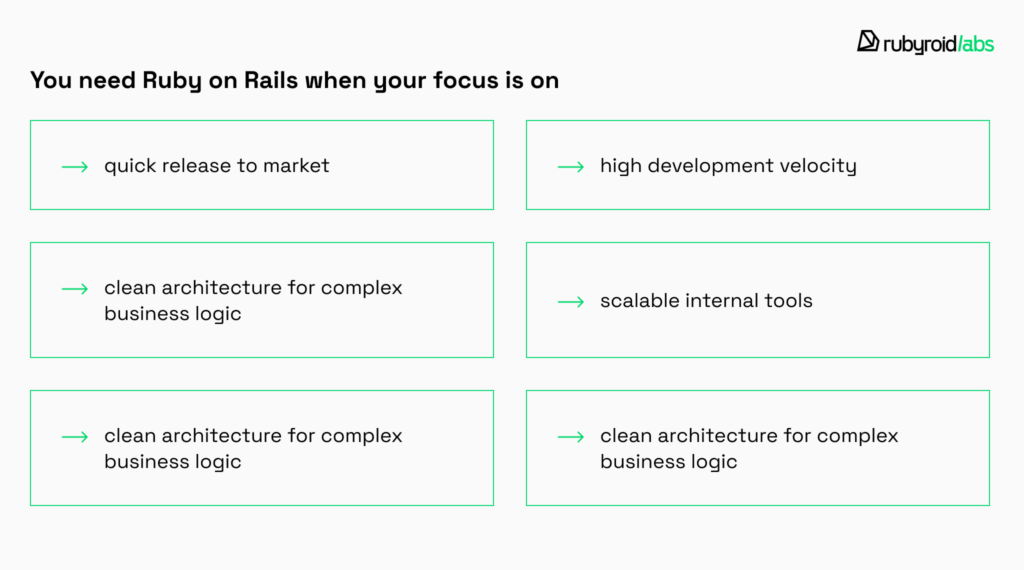
Let’s dive into the types of products where Rails is the best fit and how it’s already powering both niche and large-scale solutions.
SaaS Platforms with Complex Business Logic
CRMs, subscription tools, project management apps
RoR is a strong choice for complex systems that require background processing, custom workflows, and multi-role user management.
A CRM for car wash businesses RocketWash was built with Rails to automate operations, bookings, finances, and employee tracking. Thanks to Rails, the product scaled to support over 130 businesses with 50+ automated modules.

Fast-Moving Web Products & MVPs
Startup prototypes, product marketplaces, social platforms
Rails is perfect when speed matters. Its conventions, scaffolding, and powerful ecosystem allow teams to go from idea to prototype fast.
CoverageXpert, a specialized platform for managing insurance compliance, was built with Rails. The framework enabled the quick development of an MVP, providing an intuitive solution for B2B clients.

eCommerce & Transactional Apps
Online stores, booking platforms, ticketing systems
Rails handles transactions, user flows, and payment integrations with ease. Its mature ecosystem includes everything from Stripe integrations to solid admin panels.
Macadamia Sales Market, a B2B trading platform for macadamia nuts, uses Rails to enable real-time listings, bidding, and contract management. The system supports various product types and business roles, all while remaining scalable.

Internal Tools with Background Processing
Admin dashboards, reporting portals, automation apps
Rails + Sidekiq (or Resque) is a powerful combo for apps that need background jobs, data aggregation, and operational dashboards.
For Magoosh, we built several internal tools, including a B2B educator portal and background processing for grading and analytics. Rails made it seamless to integrate with systems like Schoology and Stripe while keeping the platform efficient.
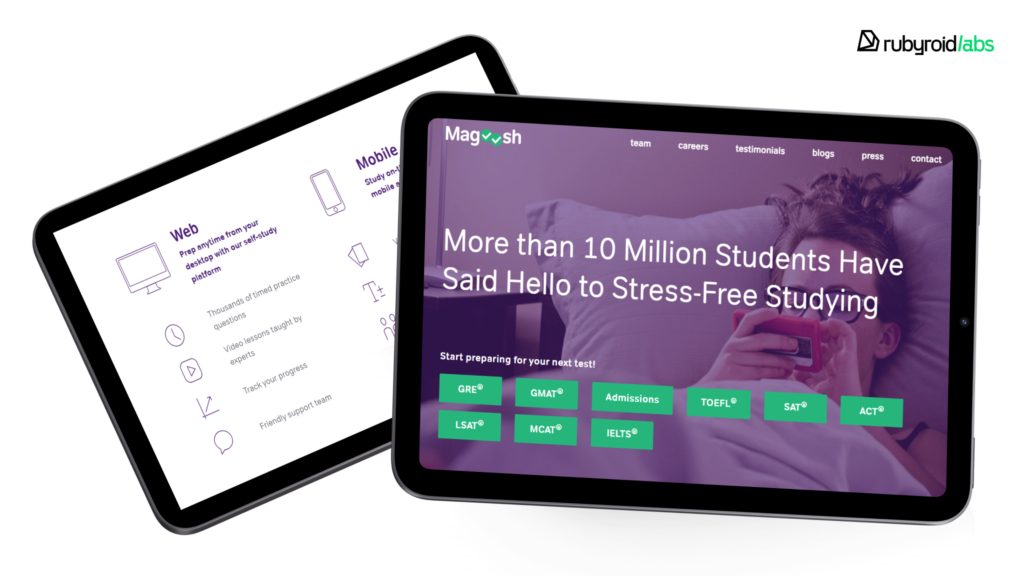
Your project can reach the market sooner than you think. Whether you’re planning an MVP to present to stakeholders, scaling a SaaS platform, or strengthening your existing product, our Ruby on Rails expertise is ready to accelerate your success.
Conclusion
When you’re gearing up to launch a product quickly, having a talented team matters, but so does picking the right technology. The goal is to choose tools that keep things moving efficiently, not ones that add unnecessary complexity or slow you down.
Your business objectives and product requirements should drive these technology decisions. The framework you choose, whether it’s Django, Node.js/Express, Laravel, or Ruby on Rails, needs to eliminate unnecessary complexity, keep your team moving at pace, and let you focus on what actually matters: building something users will want.
The best tech stack isn’t about chasing the latest trends or going with what feels familiar. It’s about finding the solution that fits your specific situation and helps you get to market without the headaches.
So, what can we say after comparing all the toolsets? Let’s sum it up.
- Django shines when you’re building data-driven platforms, dashboards, or web apps, especially if Python is your language of choice.
- Node.js is good for real-time applications, APIs, and microservices, making it a great fit when you want to use JavaScript from end to end.
- Laravel works well for PHP projects. It’s beginner-friendly, offers flexible hosting, and is especially strong for e-commerce, thanks to its rich library of ready-made solutions.
- Ruby on Rails is a favorite among startups and fast-paced teams. Its opinionated structure and built-in tools help you move quickly, letting your developers focus on building features instead of wrestling with infrastructure. Rails emphasizes productivity, security, and reliability, so you can deliver robust products without getting bogged down in repetitive setup.
So, why choose RoR?
Because it lets you turn ideas into live products faster and with fewer obstacles. Rails takes care of the tedious groundwork, so your team can zero in on what really matters: solving business challenges. While it may not be the flashiest or newest framework, it’s stable, mature, and designed for productivity. If your priority is delivering real value instead of chasing trends, Rails remains a top contender.
Still not sure which tech stack fits your vision? Consulting with an expert can help you make the right choice for your project.
